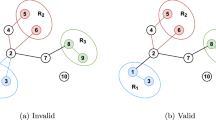Abstract
Many problems in science and engineering can be simplified into the form of a perfect binary tree. This paper discusses our study entitled Perfect Binary Tree Sequence (PBTS) which transforms a perfect binary tree into the single-row network. The transformation is necessary in applications such as in the assignment of telephone channels to caller–receiver pairs roaming in cells in a cellular network on real-time basis. In this application, each caller and receiver in a call forms a node, while their pair connection forms the edge. A specific case of the graph in the form of a binary tree is then transformed into its corresponding single-row network for assigning the channels to the caller–receiver pairs. PBTS starts with the formation of the spine from a perfect binary tree through the insertion mechanism, and this leads to the expansion of the spine into one or more zones in the single-row network. This is followed by the formation of terminals and intervals for optimal transformation into the nets of the single-row network using our earlier method called ESSR. The numerical experiment results support our hypothesis that PBTS transforms the tree into its single-row network efficiently.
Similar content being viewed by others
References
Ting B.S., Kuh E.S., Shirakawa L.: The multilayer routing problem: algorithms and necessary and sufficient conditions for the single row, single layer case. IEEE Trans. Circuit Syst. 23, 768–778 (1976)
Kuh E.S., Kashiwabara T., Fujisawa T.: On optimum single-row routing. IEEE Trans. Circuit Syst. 26(6), 361–368 (1979)
Tarng T.T., Sadowska M.M., Kuh E.S.: An efficient single-row algorithm. IEEE Trans. Comput. Aided Des. 3(3), 178–183 (1984)
Bhattacharya B.B., Deogun J.S., Sherwani N.A.: A graph theoretic approach to single row routing problems. Proc. IEEE Int. Symp. Circuit Syst. 7–9(2), 1437–1440 (1988)
Salleh S., Sanugi B., Jamaludin H., Olariu S., Zomaya A.Y.: Enhanced simulated annealing technique for the single-row routing problem. J. Supercomput. 21(3), 285–302 (2002)
Kirkpatrick S., Gelatt C.D., Vecchi M.P.: Optimization by simulated annealing. Science 220(4598), 671–678 (1983)
Salleh S., Olariu S., Sanugi B.: Single-row transformation of complete graphs. J. Supercomput. 31, 265–279 (2005)
Salleh S., Olariu S., Zomaya A.Y., Kiew L.Y., Aziz N.A.B.: Single-row mapping and transformation of connected graphs. J. Supercomput. 39, 73–89 (2007)
Author information
Authors and Affiliations
Corresponding author
About this article
Cite this article
Loh, S.L., Salleh, S. & Sarmin, N.H. Partitioning technique for transforming perfect binary trees into single-row networks. Japan J. Indust. Appl. Math. 29, 317–330 (2012). https://doi.org/10.1007/s13160-012-0071-3
Received:
Revised:
Published:
Issue Date:
DOI: https://doi.org/10.1007/s13160-012-0071-3




